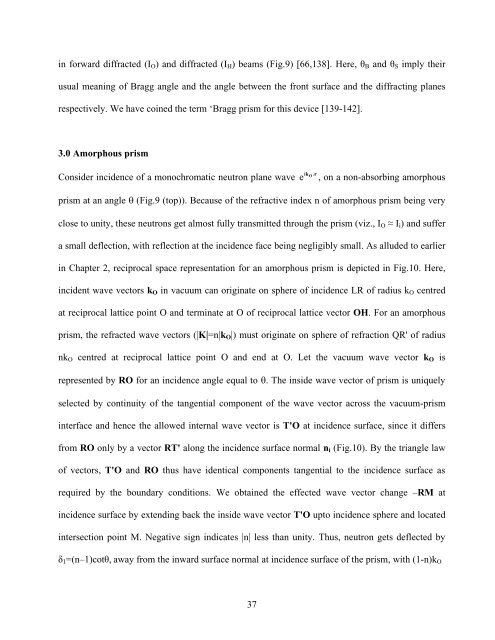PHYS01200804001 Sohrab Abbas - Homi Bhabha National Institute
PHYS01200804001 Sohrab Abbas - Homi Bhabha National Institute
PHYS01200804001 Sohrab Abbas - Homi Bhabha National Institute
You also want an ePaper? Increase the reach of your titles
YUMPU automatically turns print PDFs into web optimized ePapers that Google loves.
in forward diffracted (I O ) and diffracted (I H ) beams (Fig.9) [66,138]. Here, θ B and θ S imply their<br />
usual meaning of Bragg angle and the angle between the front surface and the diffracting planes<br />
respectively. We have coined the term ‘Bragg prism for this device [139-142].<br />
3.0 Amorphous prism<br />
Consider incidence of a monochromatic neutron plane wave<br />
i k .<br />
e O<br />
r , on a non-absorbing amorphous<br />
prism at an angle (Fig.9 (top)). Because of the refractive index n of amorphous prism being very<br />
close to unity, these neutrons get almost fully transmitted through the prism (viz., I O ≈ I i ) and suffer<br />
a small deflection, with reflection at the incidence face being negligibly small. As alluded to earlier<br />
in Chapter 2, reciprocal space representation for an amorphous prism is depicted in Fig.10. Here,<br />
incident wave vectors k O in vacuum can originate on sphere of incidence LR of radius k O centred<br />
at reciprocal lattice point O and terminate at O of reciprocal lattice vector OH. For an amorphous<br />
prism, the refracted wave vectors (|K|=n|k O |) must originate on sphere of refraction QR' of radius<br />
nk O centred at reciprocal lattice point O and end at O. Let the vacuum wave vector k O is<br />
represented by RO for an incidence angle equal to . The inside wave vector of prism is uniquely<br />
selected by continuity of the tangential component of the wave vector across the vacuum-prism<br />
interface and hence the allowed internal wave vector is T'O at incidence surface, since it differs<br />
from RO only by a vector RT' along the incidence surface normal n i (Fig.10). By the triangle law<br />
of vectors, T'O and RO thus have identical components tangential to the incidence surface as<br />
required by the boundary conditions. We obtained the effected wave vector change –RM at<br />
incidence surface by extending back the inside wave vector T'O upto incidence sphere and located<br />
intersection point M. Negative sign indicates |n| less than unity. Thus, neutron gets deflected by<br />
δ 1 =(n–1)cotθ, away from the inward surface normal at incidence surface of the prism, with (1-n)k O<br />
37
















